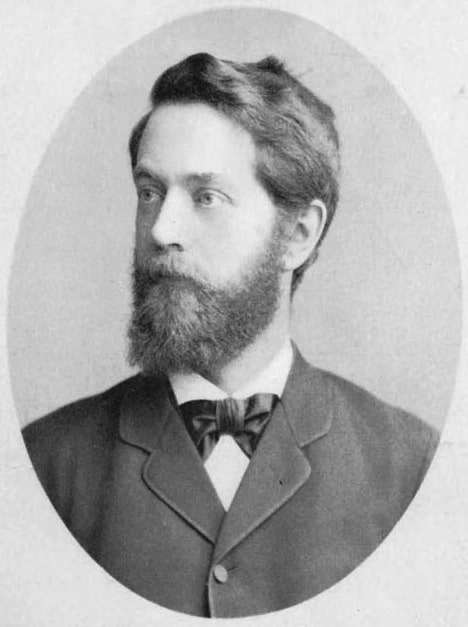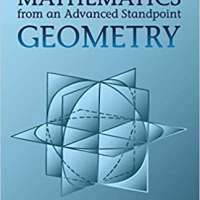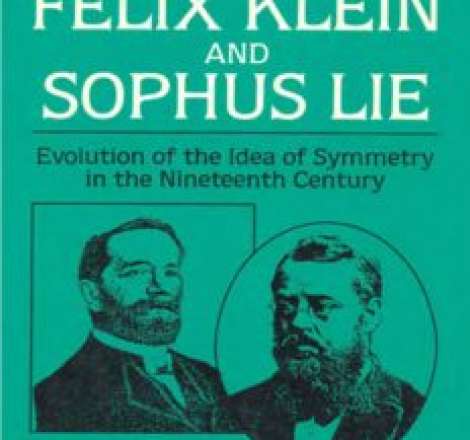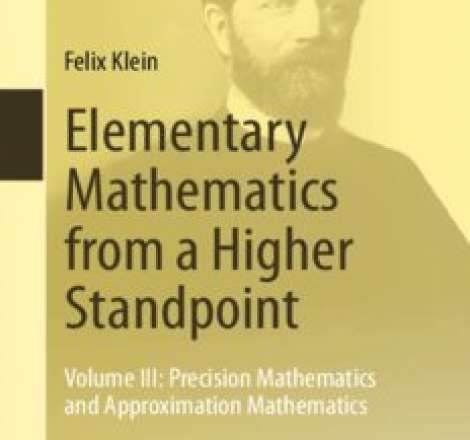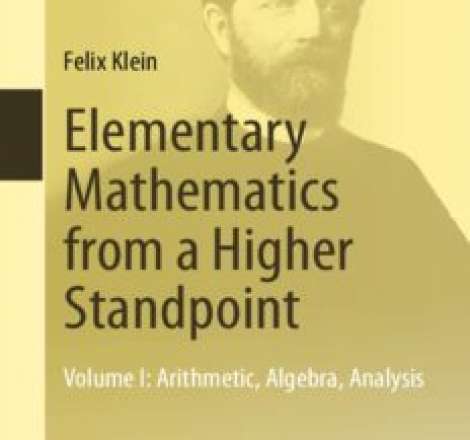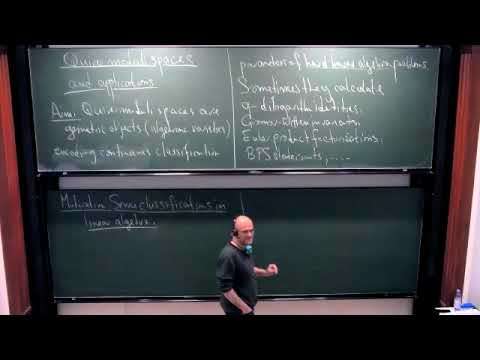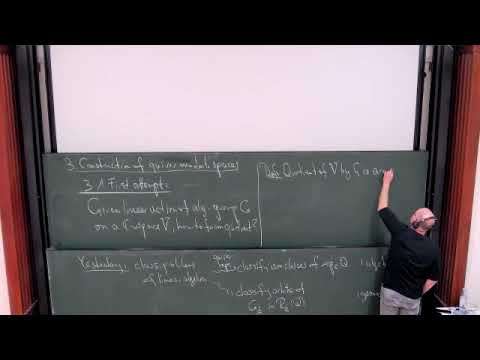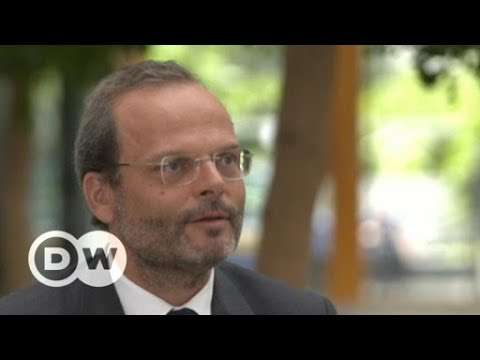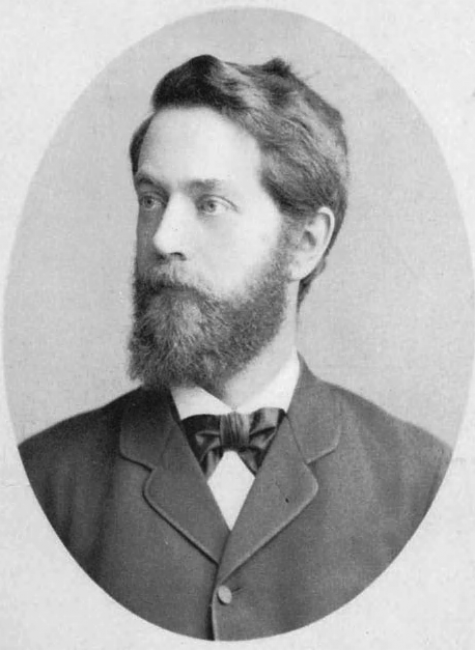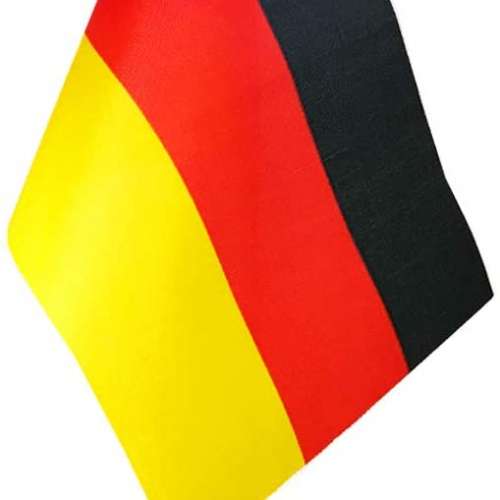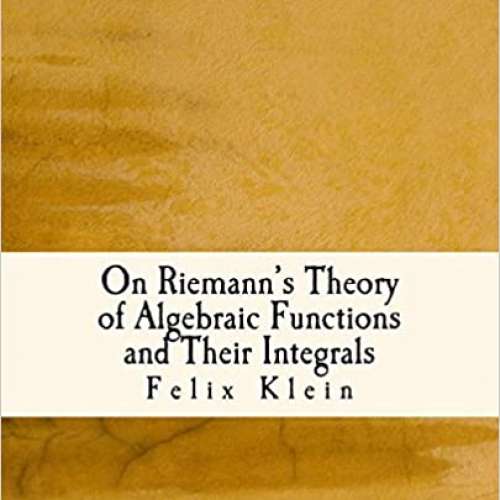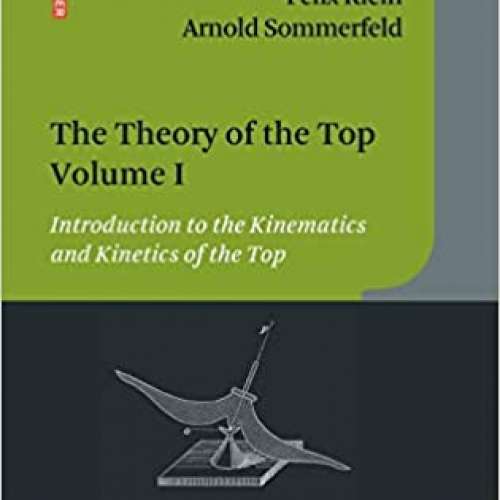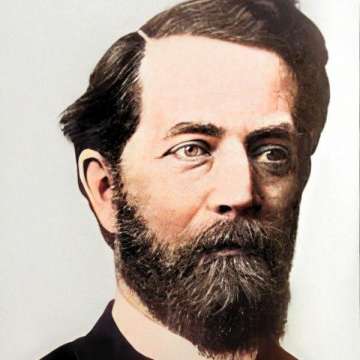

Felix Klein (1849-1925)
Everyone knows what a curve is, until he has studied enough mathematics to become confused through the countless number of possible exceptions.
Christian Felix Klein was a German mathematician and mathematics educator, known for his work with group theory, complex analysis, non-Euclidean geometry, and on the associations between geometry and group theory. His 1872 Erlangen program, classifying geometries by their basic symmetry groups, was an influential synthesis of much of the mathematics of the time.
Life
Felix Klein was born on 25 April 1849 in Düsseldorf, to Prussian parents; his father, Caspar Klein 1809–1889, was a Prussian government official's secretary stationed in the Rhine Province. Klein's mother was Sophie Elise Klein 1819–1890, née Kayser. He attended the Gymnasium in Düsseldorf, then studied mathematics and physics at the University of Bonn, 1865–1866, intending to become a physicist. At that time, Julius Plücker had Bonn's professorship of mathematics and experimental physics, but by the time Klein became his assistant, during 1866, Plücker's interest was geometry. Klein received his doctorate, supervised by Plücker, from the University of Bonn during 1868.
Plücker died during 1868, leaving his book concerning the basis of line geometry incomplete. Klein was the obvious person to complete the second part of Plücker's Neue Geometrie des Raumes, and thus became acquainted with Alfred Clebsch, who had relocated to Göttingen during 1868. Klein visited Clebsch the next year, along with visits to Berlin and Paris. During July 1870, at the beginning of the Franco-Prussian War, he was in Paris and had to leave the country. For a brief time he served as a medical orderly in the Prussian army before being appointed lecturer at Göttingen during early 1871.
Erlangen appointed Klein professor during 1872, when he was only 23 years old. For this, he was endorsed by Clebsch, who regarded him as likely to become the best mathematician of his time. Klein did not desire a school at Erlangen where there were few students, and so he was pleased to be offered a professorship at Munich's Technische Hochschule during 1875. There he and Alexander von Brill taught advanced courses to many excellent students, including, Adolf Hurwitz, Walther von Dyck, Karl Rohn, Carl Runge, Max Planck, Luigi Bianchi, and Gregorio Ricci-Curbastro.
During 1875 Klein married Anne Hegel, the granddaughter of the philosopher Georg Wilhelm Friedrich Hegel.
After five years at the Technische Hochschule, Klein was appointed to a chair of geometry at Leipzig. There his colleagues included Walther von Dyck, Rohn, Eduard Study and Friedrich Engel. Klein's years at Leipzig, 1880 to 1886, fundamentally changed his life. During 1882, his health collapsed; during 1883–1884, he was plagued by depression. Nonetheless his research continued; his seminal work on hyperelliptic sigma functions dates from around this period, being published during 1886 and 1888.
Klein accepted a professorship at the University of Göttingen during 1886. From then until his 1913 retirement, he sought to re-establish Göttingen as the world's main mathematics research center. Yet he never managed to transfer from Leipzig to Göttingen his own primacy as a developer of geometry. At Göttingen, he taught a variety of courses, mainly concerning the interface between mathematics and physics, such as mechanics and potential theory.
The research facility Klein established at Göttingen served as a model for the best such facilities throughout the world. He introduced weekly discussion meetings, and created a mathematical reading room and library. During 1895, Klein hired David Hilbert away from the University of Königsberg; this appointment proved fateful, because Hilbert continued Göttingen's good reputation until his own retirement during 1932.
With Klein's editorship, Mathematische Annalen became one of the best mathematics journals in the world. Founded by Clebsch, only with Klein's management did it first rival then surpass Crelle's Journal based in the University of Berlin. Klein established a small team of editors who met regularly, making democratic decisions. The journal specialized in complex analysis, algebraic geometry, and invariant theory at least until Hilbert ended the subject. It also provided an important outlet for real analysis and the new group theory.

During 1893 in Chicago, Klein was a major speaker at the International Mathematical Congress held as part of the World's Columbian Exposition. Due partly to Klein's efforts, Göttingen began admitting women during 1893. He supervised the first Ph.D. thesis in mathematics written at Göttingen by a woman; she was Grace Chisholm Young, an English student of Arthur Cayley's, whom Klein admired. During 1897 Klein became a foreign member of the Royal Netherlands Academy of Arts and Sciences.
About 1900, Klein began to become interested in mathematical instruction in schools. During 1905, he was decisive in formulating a plan recommending that analytic geometry, the rudiments of differential and integral calculus, and the function concept be taught in secondary schools. This recommendation was gradually implemented in many countries around the world. During 1908, Klein was elected president of the International Commission on Mathematical Instruction at the Rome International Congress of Mathematicians. With his guidance, the German part of the Commission published many volumes on the teaching of mathematics at all levels in Germany.
The London Mathematical Society awarded Klein its De Morgan Medal during 1893. He was elected a member of the Royal Society during 1885, and was awarded its Copley Medal during 1912. He retired the next year due to ill health, but continued to teach mathematics at his home for some years more.
Klein was one of the 93 signatories of the Manifesto of the Ninety-Three, a document penned in support of the German invasion of Belgium in the early stages of World War I.
Klein had the title of Geheimrat trusted-advisor.
He died in Göttingen during 1925.
Work
Klein's dissertation, on line geometry and its applications to mechanics, classified second degree line complexes using Weierstrass's theory of elementary divisors.
Klein's first important mathematical discoveries were made during 1870. In collaboration with Sophus Lie, he discovered the fundamental properties of the asymptotic lines on the Kummer surface. They later investigated W-curves, curves invariant under a group of projective transformations. It was Lie who introduced Klein to the concept of group, which was to have a major role in his later work. Klein also learned about groups from Camille Jordan.
Klein devised the "Klein bottle" named after him, a one-sided closed surface which cannot be embedded in three-dimensional Euclidean space, but it may be immersed as a cylinder looped back through itself to join with its other end from the "inside". It may be embedded in the Euclidean space of dimensions 4 and higher. The concept of a Klein Bottle was devised as a 3-Dimensional Möbius strip, with one method of construction being the attachment of the edges of two Möbius strips.
During the 1890s, Klein began studying mathematical physics more intensively, writing on the gyroscope with Arnold Sommerfeld. During 1894, he initiated the idea of an encyclopedia of mathematics including its applications, which became the Encyklopädie der mathematischen Wissenschaften. This enterprise, which endured until 1935, provided an important standard reference of enduring value.
Erlangen program
During 1871, while at Göttingen, Klein made major discoveries in geometry. He published two papers On the So-called Non-Euclidean Geometry showing that Euclidean and non-Euclidean geometries could be considered metric spaces determined by a Cayley-Klein metric. This insight had the corollary that non-Euclidean geometry was consistent if and only if Euclidean geometry was, giving the same status to geometries Euclidean and non-Euclidean, and ending all controversy about non-Euclidean geometry. Arthur Cayley never accepted Klein's argument, believing it to be circular.
Klein's synthesis of geometry as the study of the properties of a space that is invariant under a given group of transformations, known as the Erlangen program 1872, profoundly influenced the evolution of mathematics. This program was initiated by Klein's inaugural lecture as professor at Erlangen, although it was not the actual speech he gave on the occasion. The program proposed a unified system of geometry that has become the accepted modern method. Klein showed how the essential properties of a given geometry could be represented by the group of transformations that preserve those properties. Thus the program's definition of geometry encompassed both Euclidean and non-Euclidean geometry.
Presently the significance of Klein's contributions to geometry is more than evident, but not because those contributions are now considered strange or wrong. On the contrary, those contributions have become so much a part of our present mathematical thinking that it is difficult for us to appreciate their novelty, and the way in which they were not immediately accepted by all his contemporaries.
Complex analysis
Klein saw his work on complex analysis as his major contribution to mathematics, specifically his work on:
- The link between certain ideas of Riemann's and invariant theory,
- Number theory and abstract algebra;
- Group theory;
- Geometry with more than 3 dimensions and differential equations, especially equations he invented, namely elliptic modular functions and automorphic functions.
Klein showed that the modular group moves the fundamental region of the complex plane so as to tessellate that plane. During 1879, he examined the action of PSL2,7, considered as an image of the modular group, and obtained an explicit representation of a Riemann surface now termed the Klein quartic. He showed that that surface was a curve in projective space, that its equation was x3y + y3z + z3x = 0, and that its group of symmetries was PSL2,7 of order 168. His Ueber Riemann's Theorie der algebraischen Funktionen und ihre Integrale 1882 treats complex analysis in a geometric way, connecting potential theory and conformal mappings. This work drew on notions from fluid dynamics.
Klein considered equations of degree > 4, and was especially interested in using transcendental methods to solve the general equation of the fifth degree. Building on the methods of Charles Hermite and Leopold Kronecker, he produced similar results to those of Brioschi and later completely solved the problem by means of the icosahedral group. This work enabled him to write a series of papers on elliptic modular functions.
In his 1884 book on the icosahedron, Klein established a theory of automorphic functions, associating algebra and geometry. However Poincaré published an outline of his theory of automorphic functions during 1881, which resulted in a friendly rivalry between the two men. Both sought to state and prove a grand uniformization theorem that would establish the new theory more completely. Klein succeeded in formulating such a theorem and in describing a strategy for proving it. But while doing this work his health decreased, as mentioned above.
Klein summarized his work on automorphic and elliptic modular functions in a four volume treatise, written with Robert Fricke during a period of about 20 years.
Selected works
- 1882: Ueber Riemann's Theorie der Algebraischen Functionen und ihre Integrale JFM 14.0358.01
- e-text at Project Gutenberg, also available from Cornell
- 1884:Vorlesungen über das Ikosaeder und die Auflösung der Gleichungen vom 5ten Grade English translation by G. G. Morrice 1888 Lectures on the Ikosahedron; and the Solution of Equations of the Fifth Degree via Internet Archive
- English translation by G. G. Morrice 1888 Lectures on the Ikosahedron; and the Solution of Equations of the Fifth Degree via Internet Archive
- 1886: Über hyperelliptische Sigmafunktionen Erster Aufsatz p. 323–356, Mathematische Annalen Bd. 27,
- 1888: Über hyperelliptische Sigmafunktionen Zweiter Aufsatz p. 357–387, Math. Annalen, Bd. 32,
- 1894: Über die hypergeometrische Funktion
- 1894: Über lineare Differentialgleichungen der 2. Ordnung
- 1897: with Arnold Sommerfeld Theorie des Kreisels later volumes: 1898, 1903, 1910
- 1890: with Robert Fricke Vorlesungen über die Theorie der elliptischen Modulfunktionen 2 volumes and 1892
- 1894: Evanston Colloquium 1893 reported and published by Ziwet New York, 1894
- Fricke, Robert; Klein, Felix 1897, Vorlesungen über die Theorie der automorphen Functionen. Erster Band; Die gruppentheoretischen Grundlagen in German, Leipzig: B. G. Teubner, ISBN 978-1-4297-0551-6, JFM 28.0334.01 Zweiter Band. 1901.
- 1901: Gauss' wissenschaftliches Tagebuch, 1796—1814. Mit Anwendungen von Felix Klein
- Fricke, Robert; Klein, Felix 1912, Vorlesungen über die Theorie der automorphen Functionen. Zweiter Band: Die funktionentheoretischen Ausführungen und die Anwendungen. 1. Lieferung: Engere Theorie der automorphen Funktionen in German, Leipzig: B. G. Teubner., ISBN 978-1-4297-0552-3, JFM 32.0430.01
- 1897: Mathematical Theory of the Top Princeton address, New York
- 1895: Vorträge über ausgewählte Fragen der Elementargeometrie 1897: English translation by W. W. Beman and D. E. Smith Famous Problems of Elementary Geometry via Internet Archive
- 1897: English translation by W. W. Beman and D. E. Smith Famous Problems of Elementary Geometry via Internet Archive
- 1908: Elementarmathematik vom höheren Standpunkte aus Leipzig
- 1926: Vorlesungen über die Entwicklung der Mathematik im 19. Jahrhundert 2 Bände, Julius Springer Verlag, Berlin & 1927. S. Felix Klein Vorlesungen über die Entwicklung der Mathematik im 19. Jahrhundert
- 1928: Vorlesungen über nichteuklidische Geometrie, Grundlehren der mathematischen Wissenschaften, Springer Verlag
- 1933: Vorlesungen über die hypergeometrische Funktion, Grundlehren der mathematischen Wissenschaften, Springer Verlag
Bibliography
- 1887. "The arithmetizing of mathematics" in Ewald, William B., ed., 1996. From Kant to Hilbert: A Source Book in the Foundations of Mathematics, 2 vols. Oxford Uni. Press: 965–71.
- 1921. "Felix Klein gesammelte mathematische Abhandlungen" R. Fricke and A. Ostrowski eds. Berlin, Springer. 3 volumes. online copy at GDZ
- 1890. "Nicht-Euklidische Geometrie"
More facts
Klein bottle
Beltrami–Klein model
Klein's Encyclopedia of Mathematical Sciences
Copley Medal (1912)
Ackermann–Teubner Memorial Award (1914)
On Riemann's Theory of Algebraic Functions and Their Integrals
Elementary Mathematics from a Higher Standpoint: Volume I
Elementary Mathematics from an Advanced Standpoint
Lectures on the Theory of Elliptic Modular Functions


